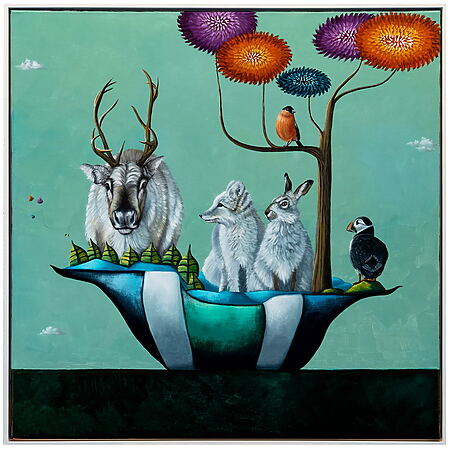Artistic photographs often disappear in the digital drawer or are staged with a picture frame in the living room. Anyone who wants a decorative highlight for the four walls will make an excellent choice with a canvas.
A photo screen gives pictures a stylish frame, optical excellence and the interior an elegant note. In order for the creative works to come into their own, it is important to take some criteria into account when selecting the photos.
These advantages offer photos on a canvas
print photos on ? The secret lies in the very special surface quality of canvases . A canvas is a high -quality fabric that is stretched on a frame. The image carrier gives photography a luxurious character and reproduces the image details with all its facets.

photo of Adam Winger @awcreativut, via Unsplash
In addition, the surface is generally not matt and mirrors t. Even in the event of a direct incidence of light, the motif does not lose meaning and comes into its own. In addition, photos receive the touch of a painting through the slightly structured tissue interface.
Perfect to focus on motifs , which are not classic subjects of creative arts. Last but not least, no fingerprints can easily be seen on a canvas. Furthermore, the tissue is considered very robust.
The right motif selection for photo screens
Photos are often snapped with the smartphone or with the digital camera. The selection of suitable motifs should therefore be carried out carefully.

Photo by
Annie Spratt @anniespratt, via unsplash
printing a canvas is worthwhile for special moments, such as a family shoot or the wedding pictures .
The following motifs are particularly good on a canvas:
- Portraits of faces
- Everyday scenes
- Landscapes
- Recordings of special events
- Animals
- Plant
- architecture
- abstract art
- self -created works of art from children's hand
In principle, however, all other motifs can also be printed onto a canvas. Creativity is by no means limited when designing.
Highlight for photo screens - photos with golden cut
Even if there is often a very personal idea behind some motifs and the memory of people and moments should be kept alive: canvases are primarily manufactured to give the room an eye catcher , and less to indulge in memories. Therefore, the technical component may also play a role in the selection of suitable photos.
Above all, the golden cut of great importance. The eye perceives motifs with such a image of image as extremely harmonious.

Photo by Friedewie, CC BY-SA 4.0, via Wikimedia Commons
This creates a certain inner calm when looking at such photos. Basically, exactly what many artists want to achieve with the preparation of art in the form of canvas photos.
Optimal image resolution for canvases
In canvases, as with all other forms of art presentation-it is important that the desired photo motif with a razor-sharp resolution appears on the textile tissue. Therefore, when choosing photos, the focus should be on a high image resolution . When making the photos, it is worth using high -resolution technology.
If this cannot be done technically, for example, because only the camera of a conventional cell phone was at hand, the actual image resolution can be compensated for with a smaller canvas format. Accordingly, it is always a good decision to put the size of the canvas and the image resolution in a suitable ratio. In this way, it can be avoided that the photo printed on canvas is unintentionally and unsightly.
Low resolution - small format
High definition wasn't in the photos taken? No problem - a canvas can still be printed excellently. If the image resolution is 460 x 310 pixels, a canvas in the 20 x 20 cm format is a good choice.
With a slightly larger image resolution, the format can be 30 x 30 cm. HD or Ultra HD quality can be presented to the audience on large screens. A resolution of 1200 x 760 pixels looks good on a canvas in a size of about 50 x 75 cm. 1400 x 920 pixels can take a seat on canvas in size 60 x 90 cm.
If you want to present the very large creative cinema, you are well advised with a canvas in the format 120 x 90 cm. Here, a image resolution of 1900 x 1400 pixels should not be undercut.
Small checklist of the influence factors for canvas quality:
- Photographer technology
- Canvas format
- Printing technology
As a rule, the technology offered for a canvas pressure is so innovative and mature that it can hide and compensate for small distortions in the pixels.
Nevertheless, the following applies: Anyone who observes the essentials from the start can later look forward to a high -quality result.
Photo set shower in preparation for canvas printing
The desired motif could be able to tolerate a richer color ? The tissue material must be taken into account when asked whether a photo should be retouched before printing on canvas.
If you prefer a natural result, you can give a subtle contrast to the picture. An too strongly retouched picture is usually also expressed just as striking due to modern printing technology.
Conclusion
Optimal results can be achieved in the canvas printing through a selective motif selection . The print preparation rounds off a suitable ratio of image resolution and format

Owner and managing director of Kunstplaza . Publicist, editor and passionate blogger in the field of art, design and creativity since 2011. Successful conclusion in web design as part of a university degree (2008). Further development of creativity techniques through courses in free drawing, expression painting and theatre/acting. Profound knowledge of the art market through many years of journalistic research and numerous collaborations with actors/institutions from art and culture.


















